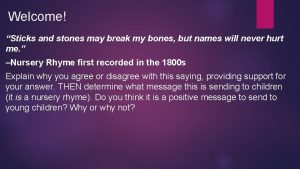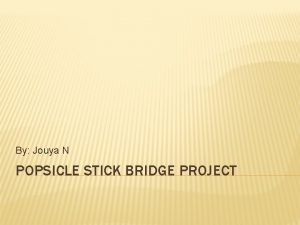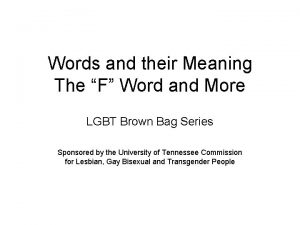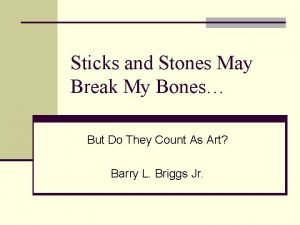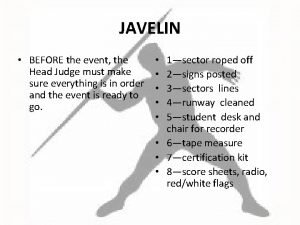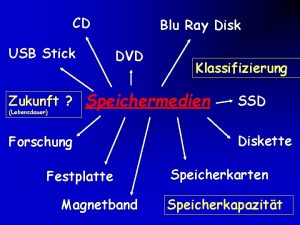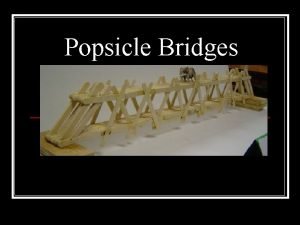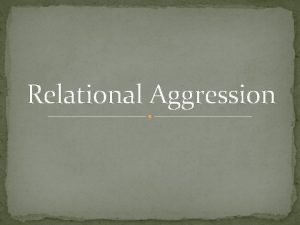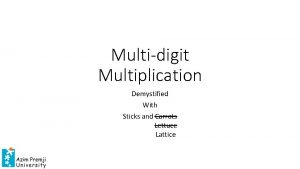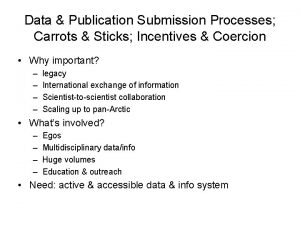Carrots or Sticks Unit 2 Day 2 CanvasOne

































- Slides: 33

Carrots or Sticks Unit 2 Day 2 Canvas/One. Note Resource

The Foreign Policy Toolbox

“Carrot – and – stick” Originated from the traditional alternatives of getting a donkey to move by either holding out a carrot or whipping it with a stick.

Carrot–and–stick foreign policy: The phrase ''carrot and the stick'' is used nowadays to characterize a foreign policy by which a nation is to be rewarded with a carrot or punished with a stick, depending on its future behavior.

Diplomatic Tools

I. Diplomatic Tools A. Diplomacy: • Conducting relations between nations through negotiations and dialogue. • “Tool of first resort” used to differences peacefully. • Carried out by diplomats (Official representatives of a country). resolve

• Diplomacy may involve summits (face to face talks) between world leaders / heads of state. Bilateral summits Multilateral summit

B. Diplomatic Relations: The formal contact / communication established between two states that normalize relations. • Diplomatic recognition is extended to each other’s governments. • Exchange Ambassadors exchanged. • Open Embassies opened in each other’s capitals.

Countries Without Diplomatic Relations with the United States: • Iran • North Korea • Bhutan • Syria

C. Diplomacy may result in the signing of treaties: § Formal, written agreements between states Peace Treaty § May be bilateral or multilateral. § When signed and ratified they become law. Commercial Treaty § Basis for international law. § Many different types. Arms Control Treaty

D. Diplomacy can lead to formation of alliances. • Formal agreements between nations to defend each other in the case of attack. • Based on the idea of collective security. Means that peace and security is achieved by states acting together to confront aggression.

Our most important alliance? NATO North Atlantic Treaty Organization NATO meeting at NATO headquarters in Brussels, Belgium.

NATO’s Expansion: 28 Members Today 1949 U. S. Canada U. K. France Italy Portugal Iceland Norway Belgium Netherlands Denmark Luxembourg 1952 Greece Turkey 1955 West Germany 1982 Spain 1990 East Germany 1999 Poland Hungary Czech Republic 2004 Slovenia Slovakia Bulgaria Romania Estonia Latvia Lithuania 2009 Croatia Albania

Major “Non-NATO Allies” of the U. S. Morocco Egypt Jordan Israel Kuwait Qatar Pakistan South Korea Japan Thailand Philippines Argentina Australia New Zealand

E. Diplomatic Sanctions • Sanctions are punishments or penalties imposed on a targeted state to persuade that state to change its behavior. • Examples of diplomatic sanctions: Ø Withholding recognition. Ø Recalling one’s own diplomats. Ø Expelling another country’s diplomats. Ø Breaking off relations.

CASE: Terms Related to Diplomacy Normalization of Relations Carrot or Stick?

Economic Tools

Economic Rewards • Free trade agreements Agreements to open up your market and allow unrestricted imports from another country.

A. Economic rewards: • Foreign aid Ø Economic aid Ø Military aid Ø Arms sales

2017 Budget:


2017 Budget:

Economic Rewards (con’t) § The lifting (removal) of sanctions.

B. Economic Punishments: • Trade restrictions: Ø Tariffs Taxes on imports Ø Quotas Limits on imports • Sanctions Ø Boycotts Refusal to buy some Ø Embargoes Cut off all trade

Economic Sanctions Are Controversial Critics say. . . Discussion on Failure of Sanctions • They are rarely effective. • They can backfire by isolating sanctioned countries and causing their leaders to become even more repressive. • They unfairly punish civilians. • They hurt U. S. businesses by cutting the markets in which they can sell their products.

Case: Senior Week? Ca r o t rro k? c i t as

Military Tools

III. Tools Related to Use of Military Force • Part of a policy of coercion (Attempting to force or compel another state to do something) • Hopefully used as last resort in resolving disputes. • Carries high costs and serious risks. Human lives are at stake.

Covert Operations Would include… • Clandestine activities Secret / undercover • Subversive activities. Designed to undermine/ overthrow a government.

Clandestine Activities…

Using Military Force … Many Options: Show of Strength The strategic positioning of military forces around the world.

Fighting Limited vs. Total Wars Limited wars: • Fought for limited objectives and with limited types of weapons. • Usually end with negotiated agreement. Total wars: • Fought without limitations on the objectives, targets, or weapons used. • Goal is usually the defeat and the unconditional surrender of the enemy. • Example: WWII

CASE: What kind of war? IRAQ 1991 IRAQ 2003 • Iraq invades Kuwait • 44 day duration • International community launches counter invasion to push him out • No further action taken • • • US invades in search of WMD 8 year presence Regime change Government change Power structure change
 Start with why carrots and sticks
Start with why carrots and sticks Beyond carrots and sticks
Beyond carrots and sticks Day 1 day 2 day 3 day 4
Day 1 day 2 day 3 day 4 Day 1 day 2 day 817
Day 1 day 2 day 817 Carrots look like eyes
Carrots look like eyes Carrot seeds
Carrot seeds Carrot dude
Carrot dude Maths in a nutshell
Maths in a nutshell Carrots, turnips, onions and celery cut into uniform slices
Carrots, turnips, onions and celery cut into uniform slices There isn't any chicken
There isn't any chicken Countable and uncountable nouns apple
Countable and uncountable nouns apple Why ice sticks to skin
Why ice sticks to skin Messin with sasquatch
Messin with sasquatch Varieties of fish and shellfish
Varieties of fish and shellfish Sticks and stones may break my bones poem
Sticks and stones may break my bones poem Strong bridge designs popsicle sticks
Strong bridge designs popsicle sticks Stove-length sticks of wood
Stove-length sticks of wood Glow stick diagram
Glow stick diagram What is a cn label
What is a cn label Popsicle stick bridge ideas
Popsicle stick bridge ideas Https://slidetodoc.com/6-4-b-the-piano-method-aka-sticks/
Https://slidetodoc.com/6-4-b-the-piano-method-aka-sticks/ Straw egg drop designs
Straw egg drop designs Lifeseasons
Lifeseasons Mineral sticks
Mineral sticks F-word это лгбт
F-word это лгбт Chris drury medicine wheel
Chris drury medicine wheel Judge hit by javelin
Judge hit by javelin Usb-stick lebensdauer
Usb-stick lebensdauer Suspension bridge out of popsicle sticks
Suspension bridge out of popsicle sticks Sticks and stones origin
Sticks and stones origin Friend that sticks closer than a brother esv
Friend that sticks closer than a brother esv How to tie lashings
How to tie lashings Wood field hockey sticks
Wood field hockey sticks Sam's club jimmy dean breakfast sandwiches
Sam's club jimmy dean breakfast sandwiches














